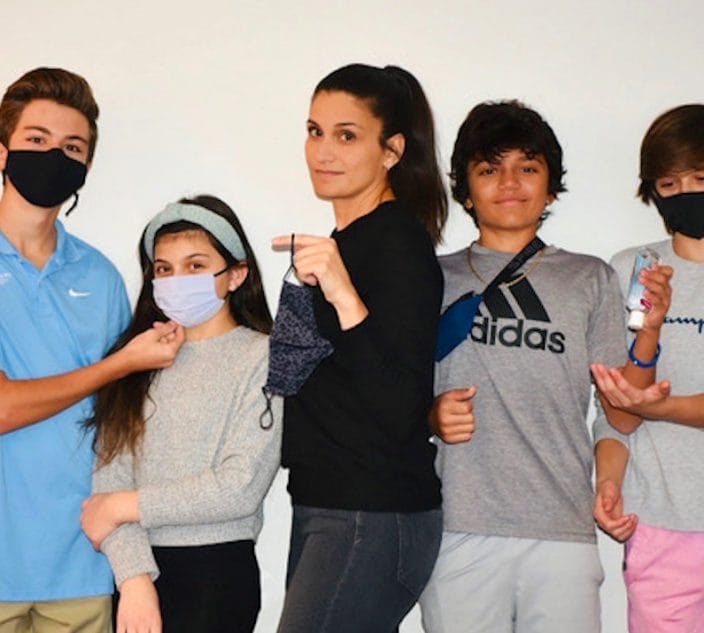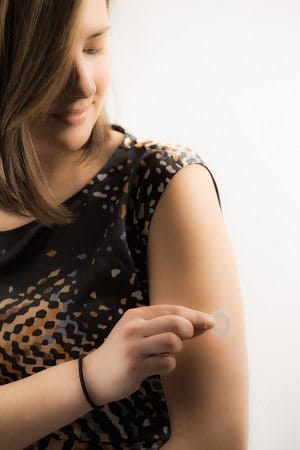The suspected “peanut kiss” death of a Quebec teen and another tragedy provide clues to what goes wrong in fatal food allergy reactions.
WHEN news surfaced that 15-year-old Christina Desforges of Saguenay, Quebec, had died of what appeared to be an anaphylactic reaction to a kiss from a boyfriend who had eaten a peanut butter sandwich, the story traveled from Canada to Mexico to South Africa and on to Europe.
The reason for the media interest was simple: it seemed incredible that death could come from the tiny amount of peanut exposure in a kiss. Not only that, but the young man had eaten his sandwich about nine hours before the kissing started.
The investigation into Christina’s death in November, 2005 raised questions about whether anaphylaxis and peanut in the kiss were to blame – or, at least, solely to blame. Coroner Michel Miron ultimately found that Christina, who had asthma and was allergic to peanut, died of a severe asthma attack. He said it was not from exposure to peanut in a kiss. [See “Update” at end of this article.]
Yet, a leading Canadian allergy expert has told Allergic Living that it can be difficult to entirely rule out anaphylaxis, the severe food allergic reaction. The condition is inter-related with asthma.
But what is certain is that Christina was having great trouble breathing at her boyfriend’s home in the early hours of November 21, 2005. If anaphylaxis or asthma or both were the cause of her respiratory distress, Allergic Living has learned this as well: contrary to the news reports, Christina did not get epinephrine promptly.
“It really was not ‘immediately’,” confirmed Dr. Nina Verreault, the Quebec allergist working with the coroner. “It was more like ‘late’.”
Used Puffer Not Auto-Injector
A month later in Canada, there was another allergy-related teenage tragedy. Chantelle Yambao of Edmonton, who was severely allergic to nuts and peanuts, ate a store-bought Nanaimo chocolate square and began to feel shortness of breath. Thinking she was having an asthma attack, the 13-year-old used her bronchodilator (or reliever puffer).
Hours passed on December 23, 2005, before she let her mother know of her breathing trouble. Then Chantelle collapsed. Her parents phoned 911, but the teen was well into a serious reaction. She lost consciousness and was put on life support in hospital. She died a few days later.
Both of these tragedies left families shattered, and in both there are lessons and disturbing parallels. For instance, each of the girls was asthmatic, food allergic and a teenager, automatically putting her into the highest risk category for fatal reactions.
While Chantelle’s death is considered the more evident case of anaphylaxis (to peanut or nut in the square she ate), each girl assumed she was having an asthma attack. In the panic of breathing distress, both Chantelle and Christina reached for a puffer, but neither administered an epinephrine auto-injector, which would have been effective in an anaphylactic episode and also in severe asthma.
In an acute asthma attack, “we tell people to use their bronchodilator, four puffs every 15 minutes,” says Dr. Susan Waserman, an allergist practicing in Hamilton, Ontario. But she says asthma is also often a key manifestation of anaphylaxis, and a puffer is not sufficient to halt this type of reaction. Anaphylaxis can have symptoms ranging from breathing trouble to vomiting or cramps, hives and itchiness, or even a potentially fatal drop in blood pressure.
Tough to Rule Out Peanut Kiss
Speaking just ahead of the coroner’s report, Waserman said that “something that looks like a death from acute asthma can in fact be part of anaphylaxis. “It would be difficult to rule out anaphylaxis. It might not be an ‘either-or’ scenario.”
A U.K. study of 130 anaphylactic deaths highlights the difficulty in making such a determination. In his 2000 report, Dr. Richard Pumphrey of the Immunology Department of St. Mary’s Hosital in Manchester found that there were no observable signs of anaphylaxis in many of the deaths. He concluded that “in the presence of a typical clinical history, absence of postmortem findings does not exclude the diagnosis of anaphylaxis.”
Waserman stresses the importance of vigilance with both asthma and food allergies, as both can be fatal. Asthma must be controlled, often with a daily regime of medication. She advises erring on the side of using the epinephrine auto-injector if an asthmatic showing breathing distress is also food allergic.
If that individual has already used a puffer and “doesn’t seem to be responding and you’re waiting for the ambulance, give the epinephrine,” she says. There are very few contraindications to using epinephrine.
Similarities with Sabrina
The absence of that lifesaving drug in the cases of Chantelle and Christina has a chilling familiarity. The late Sabrina Shannon, who became the inspiration for the province of Ontario’s law to protect anaphylactic students, collapsed at her high school in September, 2003. She did so after telling the vice principal, “it’s my asthma.”
He had sent someone to retrieve her EpiPen in case food was the cause. It was: the cafeteria fries she had eaten at lunch had been accidentally exposed to cheese curds – and dairy was one of her allergy triggers. Sabrina had had other anaphylactic episodes, but that day confused the symptoms.
“It’s critical that these kids understand if they’re eating something and they suddenly can’t breathe, they should be treating for a food allergy reaction, an accidental ingestion,” says Anne Muñoz-Furlong, former CEO of the Food Allergy and Anaphylaxis Network (now FARE). “We need to teach them not to be afraid. There’s no harm in giving epinephrine if it’s not needed, but the results of not giving it if it is needed can be catastrophic.”
Muñoz-Furlong notes that in a 2001 U.S. study of 32 anaphylaxis deaths, 54 per cent who died were kids aged 10 to 19, and 96 per cent of them “had asthma as part of their allergic profile.” Meanwhile, in an Ontario study of anaphylaxis deaths, most of the 20 who died of peanut or tree-nut allergies were again adolescents.
Learning to Speak Up
Another lesson consistent in the recent deaths and the studies is that teenagers need to learn to speak up about their allergies and asthma. Chantelle tried to treat what she perceived as an asthma attack on her own, while Christina hadn’t told either her boyfriend of 2 1/2 months or other friends staying over at his family’s house that she had an allergy to peanut.
Muñoz-Furlong says that some teenagers in the U.S. fatalities study “went off and quietly tried to take care of themselves, and the reaction overcame them. Others collapsed in front of their friends and the friends had no idea what to do.”
But if the peril to allergic teenagers is the recurring problem, the question becomes: How do you stop the pattern? Nonprofit groups in the U.S. and Canada say food-allergic teenagers and those around them must be educated on the allergy/asthma basics and the use of auto-injectors and puffers.
But beyond that, they are looking to get teenagers talking, and involved. In 2006, FAAN set up a teen advisory council to hold discussions with fellow teens, and also revamped its teen website. In the larger picture, Muñoz-Furlong says that by having safe spaces where teens can go for practical, straight-forward and confidential personal advice, “we may be able to save some lives.”
Related: 2005 Allergic Living Article:
The Peanut Kiss and Christina
IT ALL went so wrong so fast. After spending the evening of Saturday, November 19, 2005 with a bunch of friends at the home of her boyfriend in Jonquiere, Quebec, 15-year-old Christina Desforges went upstairs with him around 3 a.m. She and the boy, Yan Desormeaux, were kissing.
Within five minutes, she wasn’t feeling well and rushed down to the basement to retrieve her asthma puffer. Another friend, Michael St-Gelais, was sleeping down there. He saw Christina grab her puffer out of her backpack. She inhaled the medication, but was still struggling to breathe.
Christina said she needed air. She went up to the front door, swung it open and collapsed. Michael sprang into action to give her CPR, which he’d learned in a course in Grade 9.
Michael, whose father is a nurse and who seems conversant with basic first aid, could see that her throat was completely blocked. He believes the girl’s heart had stopped. He says he used cardiac massage to get it re-started. In the meantime, Yan raced to call 911.
“Between the time she came downstairs and the time she lost consciousness, it seemed like an hour,” remembers Michael. “But it couldn’t have been more than five to 10 minutes.”
Yan was still too devastated to speak to Allergic Living, but Michael confirmed that the boyfriend had eaten a peanut butter sandwich around 6 p.m. that Saturday. Michael does not know if Yan ate anything else after that. Neither of the boys had any inkling that Christina was allergic to peanut, and she was not wearing her medical identification bracelet.
They did know she had asthma, however. When the paramedics asked Michael to find Christina’s provincial health card, he looked through her backpack for her wallet and was surprised to find an EpiPen. But he still assumed she had had an acute asthma attack.
At press time, the coroner was still formulating his opinion on the cause of death, but asthma was the likely cause under consideration. But for Dr. Susan Waserman, past president of the Canadian Society of Allergy and Clinical Immunology, the question is less one of which of those conditions is to blame, as asthma and anaphylaxis are inter-related.
The question to her is: What triggered an episode severe enough to kill? She wonders whether Christina’s asthma had been under control, and what she was exposed to in the days and hours leading up to her death.
“What were her exposures?” Waserman asks. “Did she have an infection, was there a cat in the house, did she use an aspirin or an anti-inflammatory?” Although Christina wasn’t smoking, there had been smoking in the house that night.
Depending on an asthmatic’s triggers, “all of these things could have contributed to acute airway constriction,” explains Waserman. But that doesn’t rule out the peanut as a contributor, she says. “The food may have just tipped her over the edge. On a background of poor asthma control, it could have been the straw that broke the camel’s back.”
Teen Had New Allergies
Christina’s mother, Nathalie Desforges, says her daughter was usually mindful of her allergies, and a reliable reader of ingredient labels. But the girl was becoming increasingly allergic: shortly before her death, Christina had had reactions to green peas and pea soup.
Nathalie speaks of how she misses her only child, whom she describes as a free spirit and very full of life. She urges other young people to talk to others about their allergies and to be careful.
Since Christina died, Michael says that’s already happening in his area of Quebec. Every teen he knows with food allergies is now faithfully wearing a MedicAlert bracelet and taking the risks a lot more seriously. Having been through the wrenching experience of trying to save Christina, he stresses that teenagers need to communicate to their friends the seriousness of their allergies and asthma. “The allergic person should tell everyone that they have severe allergies.”
UPDATE: Christina’s Death Ruled Asthma
The coroner examining the death of Christina Desforges ultimately concluded that the 15-year-old died from a severe asthma attack. Dr. Michel Miron rejected the theory that the teenager might have died from an anaphylactic reaction to a “peanut kiss” with her boyfriend. The boyfriend had eaten peanut butter nine hours earlier.
Miron found it “highly improbable” that peanut was a factor, saying that too many hours had passed before the kissing took place for peanut to have remained in the boy’s saliva.
In his report, the coroner described Christina as a young woman who made little effort to control her asthma. On November 19, 2005, she had spent the day at the home of Yan Desormeaux, her boyfriend, and friends joined them for the evening. At about 3 a.m., Christina and Yan headed to bed.
Within minutes, she was struggling to breathe and used her asthma inhaler. But the coroner noted that “it didn’t seem to have any effect.” She collapsed and her boyfriend called 911.
Miron said the girl’s death raises public health issues. He stressed that asthma is can be severe but is “often downplayed by patients and their friends.” He recommended a provincial asthma awareness campaign, as well as a food allergy education program for Quebec teenagers. Although Miron said Christina’s death was not attributable to her food allergies, he found it distressing that none of her friends were even aware of her allergies.
Allergist Dr. Susan Waserman agrees that teenage awareness remains a major issue, and she reminds that the highest number of food allergy deaths are among teenagers at risk of both anaphylaxis and asthma. As asthma is also a key manifestation of anaphylaxis, she said that “it is always hard to completely rule out food allergy in these cases – acute asthma is a prominent feature of acute anaphylaxis.”
Waserman is concerned that patients who have the two conditions sometimes just medicate for asthma. She hopes that more education for food-allergic asthmatics will follow the coroner’s report. “And one of the things they need to learn is, if an inhaler isn’t slowing symptoms – give the epinephrine. Give it at the same time.”





